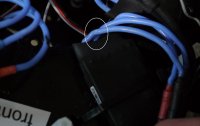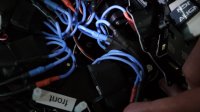Had my first major scare this morning while out flying.
Just took off and started to check everything was working, pitch roll..started to check my yaw and all of a sudden one of the motors stopped, and a whining pitch came out of it.
I still had control of it, it did not start yawing, but I had no yaw control at all.
Luckily I was not so high, so I just lowered it to the ground as quickly as possible.
I wasin that much of a panic that I did not take note of which motor it was.
I checked it all over again, and started the engines all again..this time I just kept it close to me and it flew OK or the next 13 mins.
I then changed my lipos and sent it up again, after 2 mins the same thing happened, like the propeller just locked up.
This time I was a bit more calm and brought here down, but kept the motors spinning this time, and seen that it was motor 2 on the Skyjib 6 Ti.
Now I will have to go through everything to find out what the problem is, however..where exactly do you start.
Has anyone experienced anything like this before.
I have read that it should have started oscillating if a motor fails, but obviously I know that this was not the case for me.
Thankfully it didn't happen when I was too far away or going with much speed, or it may have been a different case.
In a way I am sort of glad it has happened when it did, as it has made me a lot more wary of what could happen.
Anyone any thoughts on what should be my next steps?
Hobbywing 40A opos ESCs with tiger 3515-15 motors and Droidworx PDB
Have about 10 hours flight time with this new setup.
Just took off and started to check everything was working, pitch roll..started to check my yaw and all of a sudden one of the motors stopped, and a whining pitch came out of it.
I still had control of it, it did not start yawing, but I had no yaw control at all.
Luckily I was not so high, so I just lowered it to the ground as quickly as possible.
I wasin that much of a panic that I did not take note of which motor it was.
I checked it all over again, and started the engines all again..this time I just kept it close to me and it flew OK or the next 13 mins.
I then changed my lipos and sent it up again, after 2 mins the same thing happened, like the propeller just locked up.
This time I was a bit more calm and brought here down, but kept the motors spinning this time, and seen that it was motor 2 on the Skyjib 6 Ti.
Now I will have to go through everything to find out what the problem is, however..where exactly do you start.
Has anyone experienced anything like this before.
I have read that it should have started oscillating if a motor fails, but obviously I know that this was not the case for me.
Thankfully it didn't happen when I was too far away or going with much speed, or it may have been a different case.
In a way I am sort of glad it has happened when it did, as it has made me a lot more wary of what could happen.
Anyone any thoughts on what should be my next steps?
Hobbywing 40A opos ESCs with tiger 3515-15 motors and Droidworx PDB
Have about 10 hours flight time with this new setup.


